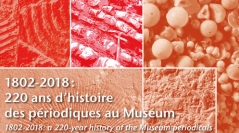


 Geodiversitas
40 (1) - Pages 1-41
Geodiversitas
40 (1) - Pages 1-411802: the young Muséum national d’Histoire naturelle takes its first step into scientific publishing with the review Annals. 2018: nearly 220 years later, the Muséum periodicals are published online as fast-track articles, available in Diamond Open Access and with XML mark-up. This thorough technical modernisation has been implemented by the Science Press team over a 20-year period.
In 1997, the Bulletins du Muséum national d’Histoire naturelle are restructured and the periodicals take the names by which they are known today: Section A, Zoologie, biologie et écologie animales becomes Zoosystema; Section B, Adansonia : Botanique, Phytochimie becomes simply Adansonia; Section C, Sciences de la Terre, paléontologie, géologie, minéralogie becomes Geodiversitas. The journal Anthropozoologica joins the ranks of the Muséum’s scientific journals in 2004, the year of its 20th anniversary. It is followed by the European Journal of Taxonomy (EJT), which was launched in 2011 as an incubator for new technologies that would serve the general interest of the Muséum’s journals.
In 1997, the Muséum’s periodicals entered into the age of international scientific publishing. Beyond a change of format, the entire workflow underwent a revolutionary overhaul: whereas the Bulletins were overseen by the Muséum faculty assembly, the review process of the new periodicals was henceforth to rely on a system of peer evaluation, coordinated by a board of renowned international scientists. While the Bulletins left an inheritance of longstanding academic traditions, the new journals opted for concise titles to facilitate citation and favour pertinent referencing, both by search engines and the Journal Citation Report, and then consolidated their identity with a shared template. By publishing in print every last Friday of the trimester (plus online from 2000), and by opening the journals to English-language articles, the professionalization of the periodicals conform to international standards was complete. The fruit of these efforts came with official indexation by the Journal Citation Report and the attribution of an impact factor for Geodiversitas, Adansonia, Zoosystema and Anthropozoologica, and finally the young EJT. Enlarging the diffusion of the Muséum’s journals over the past 20 years, firstly via the exchanges run by the Library, then via the Science Press website (launched in 1999, with major updates in 2004 and 2015) and the BioOne platform (from 2009), has also proven a beneficial strategy. The articles published in the Muséum’s journals are now distributed in over 2500 universities and available online, openly and freely, through the Science Press website.
The Muséum’s scientific journals must now strive to develop their reach even further, while maintaining high technical and scientific quality. The adoption of a fast-track online publication model comes as a response to researchers’ increasing demand for reactivity. Moreover, by converting articles into XML format, the journals will offer a durable archiving solution and a direct feed for worldwide data aggregators. The parallel distribution of all articles through the Muséum Science Press website and the BioOne platform, combined with the digitization of past issues for the Biodiversity Heritage Library, will allow the original research results entrusted to the Muséum’s journals to live on for decades more.